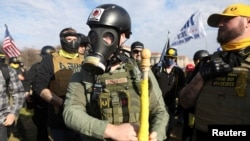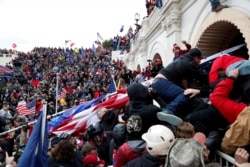Two reports are raising new concerns about the extent to which current and former members of the U.S. military have not only adopted extremist ideology but are willing to act on those beliefs.
The overall numbers, based on publicly available information, are small. Still, researchers warn the trends are alarming and highlight the need for more study, better record-keeping by the military, and the involvement of organizations for military veterans.
"The data should serve as a cautionary tale,” according to the Washington-based policy research organization Center for Strategic and International Studies (CSIS), which issued a brief Monday on The Military, Police, and the Rise of Terrorism in the United States.
“While the numbers are relatively low, they are growing—and the military and law enforcement agencies need to take preventive action now,” the brief’s authors write.
The CSIS researchers say they examined 980 cases of terrorist plots and attacks from 1994 through January 2021, paying particular attention to the past five years.
They found of the 110 domestic terrorist plots and attacks it identified in 2020, seven of them – 6.4% – involved active duty or reserve U.S. military personnel.
In comparison, active duty or reserve U.S. military personnel were linked to just 1.5% of all domestic terrorist plots and attacks in 2019 (one out of 65) and none in 2018.
Adding to their concern, of the 17 plots or attacks this past January, three -- 17.6% -- involved active duty or reserve troops.
“These challenges will persist since extremist networks seek to embed their members in the military and law enforcement agencies and to actively recruit current and retired personnel,” the CSIS brief warns.
January 6 U.S. Capitol siege
Adding to the concern, a second report, on the January 6 siege of the U.S. Capitol, finds that of the 357 people charged in federal court, 43, or 12%, had some type of military experience.
The report, by the Combating Terrorism Center at the United States Military Academy (West Point) and The George Washington University’s Program on Extremism, found that 93% of those were veterans with an average of nine years of service.
“We've got individuals who, by and large, tended to stay longer in terms of their service commitments,” said Daniel Milton, a study co-author, during a virtual event Monday to discuss the finding. Milton is also director of research at the Combating Terrorism Center.
Milton, and co-author Andrew Mines, with the Program on Extremism, further found more than a quarter of those with military experience charged in the January 6 siege of the Capitol had been commissioned officers and 44% had deployed overseas at least once.
“Several of these individuals completed extraordinarily difficult assignments and did so in courageous fashion receiving commendations, Purple Hearts and other recognition for their efforts,” Milton said.
Links to domestic extremist groups
Many of the individuals also had links to domestic violent extremist (DVE) groups.
“Our biggest takeaway here is military arrestees were four times more likely to have affiliation to those DVE organizations than individuals without military experience,” said Mines. “The contrast is pretty stark.”
The release of the reports highlighting links among active, reserve and retired military members to domestic terror plots or attacks comes just days after the U.S. Defense Department announced the results of a military-wide pause aimed at taking on extremism in the ranks.
In a memo released this past Friday, Defense Secretary Lloyd Austin called for better, standardized screening for military recruits and better training for soon-to-be veterans who could be targeted for recruitment by a number of domestic extremist groups.
The memo also established a commission to conduct a more detailed study of just how many active-duty troops subscribe to and may be willing to act on extremist beliefs – something the Pentagon is unable to pinpoint right now.
"The numbers are not very big at all but that doesn't mean that's not there,” Gen. James McConville, the Army’s chief of staff, said during an appearance on Washington Post Live Monday.
“We are very concerned about having any type of harmful behaviors that break the trust the American people," McConville added. "We're going to take the appropriate measures."
To date, defense officials have only been able to point to information from the Federal Bureau of Investigation (FBI) that of the 143 investigations opened into current and former military members in 2020, 68 were because of concerns about domestic extremism.
Researchers argue much more information is needed, and soon.
“We don't have good data,” Heidi Beirich, the co-founder and chief strategist for the Global Project Against Hate and Extremism, said at the virtual unveiling of the Combating Terrorism Center and Program on Extremism report.
“There's never been this holistic attempt to address this situation,” she said. “the problem of extremists in the ranks has always been on sort of a slow burn for a long time because it's never been given the attention that it was due.”
Beirich and other experts, however, warn that the Pentagon and veterans' groups will need more than just better data. They will need expertise that, at many levels, is lacking.
“We've got a lot of cases where one incident at one base or in one unit is handled perfectly – everything you could possibly want,” said Mark Pitcavage, with the Anti-Defamation League’s Center on Extremism.
“But [with] a very similar incident somewhere else, the personnel does not know, ‘Who do I take this to’ or what is actually the next step,” he said. “Nothing gets done simply because they didn't know.”










